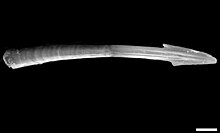
Back سهم جنسي Arabic Liebespfeil German Dardo de amor Spanish Armunool Estonian Dard d'amour French Dardo (malacologia) Italian 恋矢 Japanese 연시 (생식계) Korean Liefdespijl Dutch Strzałka miłosna Polish
This article needs additional citations for verification. (March 2023) |



A love dart (also known as a gypsobelum, shooting darts, or just as darts) is a sharp, calcareous or chitinous dart which some hermaphroditic land snails and slugs create. Love darts are both formed and stored internally in a dart sac. These darts are made in sexually mature animals only, and are used as part of the sequence of events during courtship, before actual mating takes place. Darts are quite large compared to the size of the animal: in the case of the semi-slug genus Parmarion, the length of a dart can be up to one fifth that of the semi-slug's foot.[1]
The process of using love darts in snails is a form of sexual selection.[2] Prior to copulation, each of the two snails (or slugs) attempts to "shoot" one (or more) darts into the other snail (or slug). There is no organ to receive the dart; this action is more analogous to stabbing, or to being shot with an arrow or flechette. The dart does not fly through the air to reach its target, but is "fired" as a contact shot.
The love dart is not a penial stylet (in other words, it is not an accessory organ for sperm transfer). The exchange of sperm between both of the two land snails is a completely separate part of the mating progression. Nevertheless, recent research shows that use of the dart can strongly favor the reproductive outcome for the snail that is able to lodge a dart in its partner. This is because mucus on the dart contains an allomone (pheromone-like) compound that promotes sperm preservation mechanisms in the female.[3][4]
Love darts are shaped in many distinctive ways, which vary considerably between species. What all the shapes of love darts have in common is their harpoon-like or needle-like ability to pierce.

- ^ Cite error: The named reference
Chung Hawaiiwas invoked but never defined (see the help page). - ^ Koene, Joris M. (1 August 2006). "Tales of two snails: sexual selection and sexual conflict in Lymnaea stagnalis and Helix aspersa". Integrative and Comparative Biology. 46 (4): 419–429. doi:10.1093/icb/icj040. PMID 21672754 – via academic.oup.com.
- ^ Adamo, S.A. and Chase, R. (1990), The “love dart” of the snail Helix aspersa injects A pheromone that decreases courtship duration. J. Exp. Zool., 255: 80-87. https://doi.org/10.1002/jez.1402550111
- ^ Monica Lodi, Joris M. Koene (2016) The love-darts of land snails: integrating physiology, morphology and behaviour. Journal of Molluscan Studies 82:1:1-10. https://doi.org/10.1093/mollus/eyv046
© MMXXIII Rich X Search. We shall prevail. All rights reserved. Rich X Search